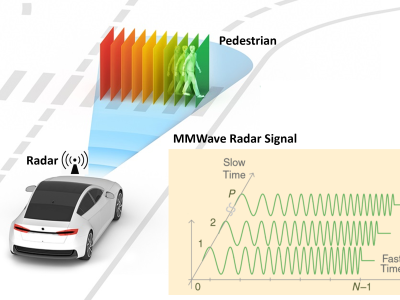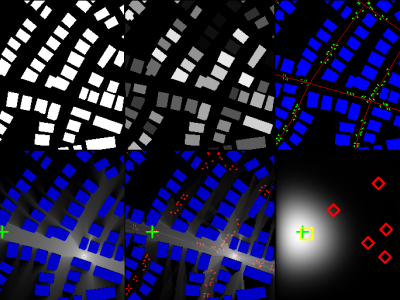CRAWDAD uportorwthaachen/vanetjamming2012

- Citation Author(s):
-
Oscar PuñalCarlos PereiraAna AguiarJames Gross
- Submitted by:
- CRAWDAD Team
- Last updated:
- DOI:
- 10.15783/C7TS35
- Data Format:
 501 views
501 views
- Categories:
Abstract
This dataset contains traces of 802.11p packets, collected in an anechoic chamber and outdoors in Porto (Portugal) in 2011, with and without the presence of an RF jamming signal with constant, reactive, and pilot jamming patterns. (dataset v. 2014-05-12)
This dataset contains several tracesets of 802.11p communications with and without the presence of a RF jamming signal. The RF jammer has different patterns of operation, namely constant, reactive and pilot jamming. First, the observations were performed inside an anechoic chamber and, finally, outdoor, in two relevant outdoor scenarios, a straight road in an open space and a dense building scenario.
date/time of measurement start: 2011-11-01
date/time of measurement end: 2012-03-09
collection environment: For the indoors, we used the anechoic chamber available at room I-106 at FEUP. For the outdoor measurements, we carried out experiments in two scenarios: a straight road in an open area with no surrounding buildings, i.e., a nearly non-dispersive environment, and a crossroad surrounded by buildings, i.e., a highly dispersive environment. We refer to the first case as open space scenario while the second scenario is referred to as university campus scenario. In neither environment there was significant movement of objects besides the transmitter and receiver involved in the experiment. For the open space scenario, the measurements were performed in an open field parking lot near the seafront of Leça da Palmeira, Porto, while in the university campus scenario they were performed in the FEUP campus.
network configuration: For the measurements, we used the Wireless Open-Access Research Platform (WARP) boards for implementing the jammer. The WARP boards provide an 802.11-like OFDM design on FPGA and a 10MHz bandwidth 802.11a/g RF transceiver, which allows transmission at frequencies up to 5.875 GHz, hence, covering 802.11p channels 172 and 174. For both the transmitter and receiver, we used NEC Linkbird 802.11p connected to a laptop Asus Eee PC running a java application to generate traffic (transmitter) and to retrieve information from the packets received at the linkbird (receiver). All reported measurements were carried out at 5.86 GHz, which corresponds to the lowest channel (Ch.172) of the frequency band allocated to 802.11p communications and is meant for public safety communications. The omni-directional antennae used in our measurements are designed to work at the 5.0-6.0 GHz band and yield a 6 dBi gain. In every experiment, the transmitter sends packets with 17.48 dBm of transmit power, at a data rate of 6 Mbps (QPSK 1/2), payload length of 100 Byte and at 100 packets per second. For the constant and reactive jamming profile, the signal has 16.75 dBm, lasts for 64 microseconds and between two consecutive transmission, there is a unavoidable preparation time of 10 microseconds. The reactive jamming profile has a energy detection threshold of -75 dBm, a detection time of the reactive profile lasts 1.2 microseconds and a total reaction delay is uniformly distributed between [11.2-21.2] microseconds. Regarding the pilot jammer profile, it has a transmitted power of 2.42 dBm, a duration of 2.04 ms and the preparation time of 10 microseconds.
data collection methodology: Log files from a java application was used along with the traces generated by the two linkbirds (plus the gps readings, for the outdoor measurements) to assess the impact of the jammer.
Tracesets
chamberpathloss
Traceset collected in the anechoic chamber to calculate the pathloss between Transmitter and Receiver, Jammer and Transmitter, and Jammer and Receiver.
- files: uportorwthaachen-vanetjamming2012.tar.gz, jammer_rx.tar.gz, tx_jammer.tar.gz, tx_rx.tar.gz
- methodology: We placed the transmitter antenna on a pole typically used for radiation pattern measurements and the jammer antenna on the pair pole. The receive antenna was placed on top of an empty cardboard box at a similar height as the other two antennas. The jamming, the transmitter and the receiver devices were placed outside the chamber, connected through high performance cabling to the antennas. We measured the pathloss attenuation between all pairs of devices through the transmitted and received power.
- format: trace.txt is a text file generated from the linkbird the contact where a certain device is seen with the timestamp information, from where the packet is from, the type and size of packet. java.txt is a text file generated from java application running in the laptops. It gathers the following information (gps information only for outdoors):
-nodeid: node identifier
-systime: system time
-gpstime: gps time
-type: message type
-mid: message identifier
-psize: packet size
-mylat: node latitude
-mylong: node longitude
-myalt: node altitude
-myheading: node heading
-myspeed: node speed
-srcnodeid: identifier of the message sender
-srclat: latitude of the message sender
-srclong: longitude of the message sender
-srcalt: altitude of the message sender
-srchead: heading of the message sender
-srcspeed: speed of the message sender
-srcgpstime: gps time of the message sender
-dist: distance between sender and receiver
chamberpathloss traces
- jammer_rx: Trace collected in the anechoic chamber to calculate the pathloss between Jammer and Receiver.
- configuration: We placed the jammer antenna on a pole and the receiver antenna was placed on top of an empty cardboard box at a similar height as the other antenna. They were 1.20 meters apart from each other. The jamming and the receiver devices were placed outside the chamber, connected through high performance cabling to the antennas. We measured the pathloss attenuation between the Jammer and Receiver through the transmitted and received power.
- tx_jammer: Trace collected in the anechoic chamber to calculate the pathloss between Transmitter and Jammer.
- configuration: We placed the transmitter antenna on a pole typically used for radiation pattern measurements and the receive antenna was placed on top of an empty cardboard box at a similar height as the other antenna. They were 4.30 meters apart from each other. The transmitter and jamming devices were placed outside the chamber, connected through high performance cabling to the antennas. We measured the pathloss attenuation between the Transmitter and Jammer through the transmitted and received power.
- tx_rx: Trace collected in the anechoic chamber to calculate the pathloss between Transmitter and Receiver.
- configuration: We placed the transmitter antenna on a pole typically used for radiation pattern measurements and the receive antenna was placed on top of an empty cardboard box at a similar height as the other antenna. They were 3.80 meters apart from each other. The transmitter and receiver devices were placed outside the chamber, connected through high performance cabling to the antennas. We measured the pathloss attenuation between the Transmitter and Receiver through the transmitted and received power.
lab
Traceset collected in the anechoic chamber under various jamming profiles.
- files: jammerconstant_varyatt.tar.gz, jammerconstant5MHz_varyatt.tar.gz, jammerconstantpilot_varyatt.tar.gz, jammeroff_varyatt.tar.gz, jammeroff_varytxpwr.tar.gz, jammerreactive_varyatt.tar.gz, nojammer_30k.tar.gz, nojammer_100k.tar.gz
- methodology: We placed the transmitter antenna on a pole typically used for radiation pattern measurements and the jammer antenna on the pair pole. The receive antenna was placed on top of an empty cardboard box at a similar height as the other two antennas. The jamming, the transmitter and the receiver devices were placed outside the chamber, connected through high performance cabling to the antennas. We configured the sending application to transmit sequences of 10000 packets and measured the SNIR of all correctly received packets and the packet delivery rate (PDR). We reduced the effective output power of the jammer by adding attenuators between the RF output of the WARP board and the antenna to obtain different values of average SNIR at the receiver. To characterize the Ambient Noise Immunity (ANI), we performed two measurements without jammer by sending 30000 and 100000 packets in each one.
- format: trace.txt is a text file generated from the linkbird the contact where a certain device is seen with the timestamp information, from where the packet is from, the type and size of packet. java.txt is a text file generated from java application running in the laptops. It gathers the following information (gps information only for outdoors):
-nodeid: node identifier
-systime: system time
-gpstime: gps time
-type: message type
-mid: message identifier
-psize: packet size
-mylat: node latitude
-mylong: node longitude
-myalt: node altitude
-myheading: node heading
-myspeed: node speed
-srcnodeid: identifier of the message sender
-srclat: latitude of the message sender
-srclong: longitude of the message sender
-srcalt: altitude of the message sender
-srchead: heading of the message sender
-srcspeed: speed of the message sender
-srcgpstime: gps time of the message sender
-dist: distance between sender and receiver
lab traces
- jammerconstant_varyatt: Trace collected in the anechoic chamber using a constant RF jamming profile. We added attenuators to the jammer to obtain different values of average SNIR at the receiver.
- configuration: We placed the transmitter antenna on a pole typically used for radiation pattern measurements and the jammer antenna on the pair pole. The receive antenna was placed on top of an empty cardboard box at a similar height as the other two antennas. The jamming, the transmitter and the receiver devices were placed outside the chamber, connected through high performance cabling to the antennas. The jammer was operating constantly. We configured the sending application to transmit sequences of 10000 packets and measured the SNIR of all correctly received packets and the packet delivery rate (PDR). We reduced the effective output power of the jammer by adding attenuators between the RF output of the WARP board and the antenna to obtain different values of average SNIR at the receiver.
- jammerconstant5MHz_varyatt: Trace collected in the anechoic chamber using a constant RF jamming profile with its center frequency shifted by 5MHz. We add attenuators to the jammer obtain different values of average SNIR at the receiver.
- configuration: We placed the transmitter antenna on a pole typically used for radiation pattern measurements and the jammer antenna on the pair pole. The receive antenna was placed on top of an empty cardboard box at a similar height as the other two antennas. The jamming, the transmitter and the receiver devices were placed outside the chamber, connected through high performance cabling to the antennas. The jammer was operating constantly but with its center frequency shifted by 5 MHz. We configured the sending application to transmit sequences of 10000 packets and measured the SNIR of all correctly received packets and the packet delivery rate (PDR). Here, we reduced the effective output power of the jammer by adding attenuators between the RF output of the WARP board and the antenna to obtain different values of average SNIR at the receiver.
- jammerconstantpilot_varyatt: Trace collected in the anechoic chamber using a constant RF jamming profile emitting exclusively on the pilot sub-carriers. We added attenuators to the jammer to obtain different values of average SNIR at the receiver.
- configuration: We placed the transmitter antenna on a pole typically used for radiation pattern measurements and the jammer antenna on the pair pole. The receive antenna was placed on top of an empty cardboard box at a similar height as the other two antennas. The jamming, the transmitter and the receiver devices were placed outside the chamber, connected through high performance cabling to the antennas. The jammer was operating constantly but emitting exclusively on the pilot sub-carriers. We configured the sending application to transmit sequences of 10000 packets and measured the SNIR of all correctly received packets and the packet delivery rate (PDR). We reduced the effective output power of the jammer by adding attenuators between the RF output of the WARP board and the antenna to obtain different values of average SNIR at the receiver.
- jammeroff_varyatt: Trace collected in the anechoic chamber with no jammer. We added attenuators to the transmitter to obtain different values of average SNIR at the receiver.
- configuration: We placed the transmitter antenna on a pole typically used for radiation pattern measurements and the receive antenna was placed on top of an empty cardboard box at a similar height as the other antenna. The transmitter and the receiver devices were placed outside the chamber, connected through high performance cabling to the antennas. We configured the sending application to transmit sequences of 10000 packets and measured the SNIR of all correctly received packets and the packet delivery rate (PDR). We reduced the effective output power of the transmitter by adding attenuators between the RF output of the transmitter's linkbird and its antenna to obtain different values of average SNIR at the receiver.
- jammeroff_varytxpwr: Trace collected in the anechoic chamber with no jammer. We varied the transmitter power to obtain different values of average SNIR at the receiver.
- configuration: We placed the transmitter antenna on a pole typically used for radiation pattern measurements and the receive antenna was placed on top of an empty cardboard box at a similar height as the other antenna. The transmitter and the receiver devices were placed outside the chamber, connected through high performance cabling to the antennas. We configured the sending application to transmit sequences of 10000 packets and measured the SNIR of all correctly received packets and the packet delivery rate (PDR). We varied transmitter power to obtain different values of average SNIR at the receiver.
- jammerreactive_varyatt: Trace collected in the anechoic chamber using a reactive RF jamming profile. We added attenuators to the jammer to obtain different values of average SNIR at the receiver.
- configuration: We placed the transmitter antenna on a pole typically used for radiation pattern measurements and the jammer antenna on the pair pole. The receive antenna was placed on top of an empty cardboard box at a similar height as the other two antennas. The jamming, the transmitter and the receiver devices were placed outside the chamber, connected through high performance cabling to the antennas. The jammer was operating with the reactive profile. We configured the sending application to transmit sequences of 10000 packets and measured the SNIR of all correctly received packets and the packet delivery rate (PDR). We reduced the effective output power of the jammer by adding attenuators between the RF output of the WARP board and the antenna to obtain different values of average SNIR at the receiver.
- nojammer_30k: Trace collected in the anechoic chamber with no jammer. The transmitter sent 30000 packets to characterize the ANI.
- configuration: We placed the transmitter antenna on a pole typically used for radiation pattern measurements and the receive antenna was placed on top of an empty cardboard box at a similar height as the other antenna. The transmitter and the receiver devices were placed outside the chamber, connected through high performance cabling to the antennas. We configured the sending application to transmit sequences of 30000 packets (instead of the 10000 packets) and measured the SNIR of all correctly received packets and the packet delivery rate (PDR) to characterize the Ambiente Noise Immunity.
- nojammer_100k: Trace collected in the anechoic chamber with no jammer. The transmitter sent 100000 packets to characterize the ANI.
- configuration: We placed the transmitter antenna on a pole typically used for radiation pattern measurements and the receive antenna was placed on top of an empty cardboard box at a similar height as the other antenna. The transmitter and the receiver devices were placed outside the chamber, connected through high performance cabling to the antennas. We configured the sending application to transmit sequences of 100000 packets (instead of the 10000 packets) and measured the SNIR of all correctly received packets and the packet delivery rate (PDR) to characterize the Ambiente Noise Immunity.
nojammer
Traceset collected in the university campus under no jammer interference and with two different mobility profiles.
- files: approaching.tar.gz, platooning.tar.gz
- methodology: For this measurement, transmitter and receiver were placed inside standard vehicles and their antennas were located in the middle of the roof of each vehicle. Then, we measured the receiver response for two different vehicular mobility, namely approaching and platooning.
- format: trace.txt is a text file generated from the linkbird the contact where a certain device is seen with the timestamp information, from where the packet is from, the type and size of packet. gpslog.txt is a text log file generated by gps device. java.txt is a text file generated from java application running in the laptops. It gathers the following information (gps information only for outdoors):
-nodeid: node identifier
-systime: system time
-gpstime: gps time
-type: message type
-mid: message identifier
-psize: packet size
-mylat: node latitude
-mylong: node longitude
-myalt: node altitude
-myheading: node heading
-myspeed: node speed
-srcnodeid: identifier of the message sender
-srclat: latitude of the message sender
-srclong: longitude of the message sender
-srcalt: altitude of the message sender
-srchead: heading of the message sender
-srcspeed: speed of the message sender
-srcgpstime: gps time of the message sender
-dist: distance between sender and receiver
no jammer traces
- approaching: Trace collected in university campus with no jammer. Receiver drives two times around the block, while the transmitter is static near the intersection (exit of the parking lot).
- configuration: For this measurement, transmitter and receiver were placed inside standard vehicles and their antennas were located in the middle of the roof of each vehicle. Receiver drives two times around the block with speed approx. 20-25km/h, while the transmitter is static near the intersection (exit of the parking lot). When the receiver passes for the second lap, the transmitter starts moving backwards until the end of the parking lot. The receiver finishes the second lap and returns back to the parking lot.
- platooning: Trace collected in university campus with no jammer. Receiver drives around the block two times, followed by the transmitter.
- configuration: For this measurement, transmitter and receiver were placed inside standard vehicles and their antennas were located in the middle of the roof of each vehicle. Receiver drives around the block two times, followed by the transmitter. The speed is approx. 20-25km/h and the distance between transmitter and receiver varies in the range of 5m-20m (closer in the curves, farther while driving straight).
openspace
Traceset collected in an open field parking lot near the seafront with a total length of 500 m with no surrounding buildings, where we used different RF jamming profiles and vehicular mobility.
- files: approaching_linear.tar.gz, approaching_rxstatic.tar.gz, approaching_txstatic.tar.gz, nojammer.tar.gz, platooning.tar.gz
- methodology: An open field parking lot near the seafront with a total length of 500 m was used for these measurements. The jammer was located 180 m from the north end of the parking lot and slightly over 300 m from the south end. During the measurements, a few vehicles sporadically drove by (from north to south and vice-versa) at speeds up to 60 kph on a parallel street located 30-meters away. We used different RF jamming profiles and different vehicular mobility scenarios.
- format: trace.txt is a text file generated from the linkbird the contact where a certain device is seen with the timestamp information, from where the packet is from, the type and size of packet. gpslog.txt is a text log file generated by gps device. java.txt is a text file generated from java application running in the laptops. It gathers the following information (gps information only for outdoors):
-nodeid: node identifier
-systime: system time
-gpstime: gps time
-type: message type
-mid: message identifier
-psize: packet size
-mylat: node latitude
-mylong: node longitude
-myalt: node altitude
-myheading: node heading
-myspeed: node speed
-srcnodeid: identifier of the message sender
-srclat: latitude of the message sender
-srclong: longitude of the message sender
-srcalt: altitude of the message sender
-srchead: heading of the message sender
-srcspeed: speed of the message sender
-srcgpstime: gps time of the message sender
-dist: distance between sender and receiver
openspace traces
- approaching_linear: Trace collected in an open field parking lot near the seafront with a total length of 500 m with no surrounding buildings. Transmitter and receiver approximated each other from opposite directions, crossing each-other near the jammer. The experiment was performed for constant and reactive jamming profiles.
- configuration: For this measurement, jammer, transmitter and receiver were placed inside standard vehicles and their antennas were located in the middle of the roof of each vehicle. Transmitter and receiver started at opposite ends of the parking lot and approximate from opposite directions at approx. 20-25 km/h, crossing each-other near the jammer, that was located 180 m from the north end of the parking lot and slightly over 300 m from the south end. The jammer operated with a constant or reactive jamming profiles. During the measurements, a few vehicles sporadically drove by (from north to south and vice-versa) at speeds up to 60 kph on a parallel street located 30-meters away.
- approaching_rxstatic: Trace collected in an open field parking lot near the seafront with a total length of 500 m with no surrounding buildings. Receiver was placed next to the jammer and the transmitter moved from the south to the north end and back. The experiment was performed only for for reactive jamming profile.
- configuration: For this measurement, jammer, transmitter and receiver were placed inside standard vehicles and their antennas were located in the middle of the roof of each vehicle. Receiver was placed next to the jammer, that was located 180 m from the north end of the parking lot and slightly over 300 m from the south end, and the transmitter moved from the south to the north end and back at approx. 20-25 km/h. The experiment was performed only for reactive jamming profile. During the measurements, a few vehicles sporadically drove by (from north to south and vice-versa) at speeds up to 60 kph on a parallel street located 30-meters away.
- approaching_txstatic: Trace collected in an open field parking lot near the seafront with a total length of 500 m with no surrounding buildings. Transmitter was placed next to the jammer and the receiver moved from the north to the south end and back. The experiment was performed only for constant jamming profile.
- configuration: For this measurement, jammer, transmitter and receiver were placed inside standard vehicles and their antennas were located in the middle of the roof of each vehicle. Transmitter was placed next to the jammer, that was located 180 m from the north end of the parking lot and slightly over 300 m from the south end, and the receiver moved from the north to the south end and back at approx. 20-25 km/h. The experiment was performed only for constant jamming profile. During the measurements, a few vehicles sporadically drove by (from north to south and vice-versa) at speeds up to 60 kph on a parallel street located 30-meters away.
- nojammer: Trace collected in an open field parking lot near the seafront with a total length of 500 m with no surrounding buildings. Transmitter started off at the north end of the parking lot, followed by the receiver, and drove south past the jammer, which was turned off, to the south end of the parking lot, where they turn and drive back to the starting point. The inter-vehicle distance was kept almost constant.
- configuration: For this measurement, transmitter and receiver were placed inside standard vehicles and their antennas were located in the middle of the roof of each vehicle. The jammer was turned off. Transmitter started off at the north end of the parking lot at approx. 20-25 km/h, followed by the receiver, and drove to the south end of the parking lot, where they turn and drive back to the starting point. The inter-vehicle distance was kept almost constant and, during the measurement, a few vehicles sporadically drove by (from north to south and vice-versa) at speeds up to 60 kph on a parallel street located 30-meters away.
- platooning: Trace collected in an open field parking lot near the seafront with a total length of 500 m with no surrounding buildings. Transmitter started off at the north end of the parking lot, followed by the receiver, and drove south past the jammer, to the south end of the parking lot, where they turn and drive back to the starting point. The inter-vehicle distance was kept almost constant. The experiment was performed for constant and reactive jamming profiles.
- configuration: For this measurement, jammer, transmitter and receiver were placed inside standard vehicles and their antennas were located in the middle of the roof of each vehicle. Transmitter started off at the north end of the parking lot at approx. 20-25 km/h, followed by the receiver, and drove south past the jammer, to the south end of the parking lot, where they turn and drive back to the starting point. The jammer was located 180 m from the north end of the parking lot and slightly over 300 m from the south end. The inter-vehicle distance was kept almost constant and, during the measurement, a few vehicles sporadically drove by (from north to south and vice-versa) at speeds up to 60 kph on a parallel street located 30-meters away.
universitycampus
Traceset collected in the FEUP campus for different vehicular mobility and RF jamming profiles.
- files: approaching_txstatic.tar.gz, platooning.tar.gz
- methodology: The transmitter and receiver were placed inside standard vehicles and their antennas were located in the middle of the roof of each vehicle. The jammer was inside a window near the located near the window of a Lab close to the parking lot. Then, we measured the receiver response for two different vehicular mobility, namely approaching and platooning.
- format: trace.txt is a text file generated from the linkbird the contact where a certain device is seen with the timestamp information, from where the packet is from, the type and size of packet. gpslog.txt is a text log file generated by gps device. java.txt is a text file generated from java application running in the laptops. It gathers the following information (gps information only for outdoors):
-nodeid: node identifier
-systime: system time
-gpstime: gps time
-type: message type
-mid: message identifier
-psize: packet size
-mylat: node latitude
-mylong: node longitude
-myalt: node altitude
-myheading: node heading
-myspeed: node speed
-srcnodeid: identifier of the message sender
-srclat: latitude of the message sender
-srclong: longitude of the message sender
-srcalt: altitude of the message sender
-srchead: heading of the message sender
-srcspeed: speed of the message sender
-srcgpstime: gps time of the message sender
-dist: distance between sender and receiver
universitycampus trace
- platooning: Trace collected in university campus with no jammer. Receiver drives two times around the block followed by the transmitter. The jammer is located near the window of a Lab close to the parking lot. Perform this measurement for constant and reactive jamming profile.
- configuration: For this measurement, transmitter and receiver were placed inside standard vehicles and their antennas were located in the middle of the roof of each vehicle. Receiver drives two times around the block with speed approx. 20-25km/h followed by the transmitter. The distance between transmitter and receiver varies in the range of 5m-20m (closer in the curves, farther while driving straight). The jammer is located near the window of a Lab close to the parking lot and operates with the constant or reactive jamming profile.
Instructions:
The files in this directory are a CRAWDAD dataset hosted by IEEE DataPort.
About CRAWDAD: the Community Resource for Archiving Wireless Data At Dartmouth is a data resource for the research community interested in wireless networks and mobile computing.
CRAWDAD was founded at Dartmouth College in 2004, led by Tristan Henderson, David Kotz, and Chris McDonald. CRAWDAD datasets are hosted by IEEE DataPort as of November 2022.
Note: Please use the Data in an ethical and responsible way with the aim of doing no harm to any person or entity for the benefit of society at large. Please respect the privacy of any human subjects whose wireless-network activity is captured by the Data and comply with all applicable laws, including without limitation such applicable laws pertaining to the protection of personal information, security of data, and data breaches. Please do not apply, adapt or develop algorithms for the extraction of the true identity of users and other information of a personal nature, which might constitute personally identifiable information or protected health information under any such applicable laws. Do not publish or otherwise disclose to any other person or entity any information that constitutes personally identifiable information or protected health information under any such applicable laws derived from the Data through manual or automated techniques.
Please acknowledge the source of the Data in any publications or presentations reporting use of this Data.
Citation:
Oscar Puñal, Carlos Pereira, Ana Aguiar, James Gross, uportorwthaachen/vanetjamming2012, https://doi.org/10.15783/C7TS35 , Date: 20140512
Dataset Files
- chamberpathloss
- index.html (946 bytes)
- lab
- index.html (3.04 KB)
- jammerconstant5MHz_varyatt.tar.gz (1.65 MB)
- jammerconstant_varyatt.tar.gz (3.13 MB)
- jammerconstantpilot_varyatt.tar.gz (1.43 MB)
- jammeroff_varyatt.tar.gz (2.6 MB)
- jammeroff_varytxpwr.tar.gz (1.57 MB)
- jammerreactive_varyatt.tar.gz (876.76 KB)
- nojammer_100k.tar.gz (1.66 MB)
- nojammer_30k.tar.gz (486.9 KB)
- nojammer
- openspace
- universitycampus
- uportorwthaachen-vanetjamming2012-20140512.xml (63.75 KB)
















